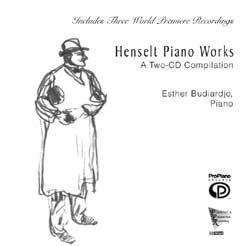|
|
|
|
|
|
|
PPR number: 224540 & 224541  |
Esther Budiardjo, Piano Henselt Piano Works (2 CDs)
|
||||||||||||||||||||||||||||||||||||||||||||||||||||||||||||||||||||||||||
| A contemporary of Mendelssohn,
Schumann, Chopin and Liszt, Adolph Henselt achieved acclaim as pianist-composer
upon the publication of his op.1 in 1837. In a review, Robert Schumann
put him among the very best in the young artistic ranks, proclaiming,
But what I call euphony, the magic of tone, has never so struck me, to
the highest degree, as in Henselts compositions. Having studied with
Hummel in Weimar, Sechter in Vienna and others, Henselt was compelled
to rethink his entire approach to piano playing after hearing Thalberg
played in concert. His 12 Études caractéristiques op.2 and 12 Études de
salon op.5 in this recording, published in 1837 and 1838 respectively,
were the fruits of this new approach, which consisted mainly of achieving
a superior tone, even in soft passages, and the ability to cover larger
areas of the keyboard through stretching of the hands. At this fertile
period of creativity, Henselt published two other pieces of comparable
style to the studies: Poëme damour op.3 and Rhapsodie op.4 no.1, the
first of which was dedicated to his wife, Rosalie Vogel, whom he married
in 1837. The 12 Études of op.2 are preceded by French titles, which mostly describe the sorrows and joys of romantic love. By contrast, the titles of op.5 are primarily in German, and the nature of several of them (Ave Maria, Danklied Nach Sturm, Nächtlicher Geisterzug) suggests a shift in expression, toward that of spirituality. It has been pointed out by Richard Davis that in addition to a similarity in pianistic style, the 24 Études of op.2 and op.5 are unified by their completion of the entire set of major and minor keys. 1839 (one year after Henselts adoption of Russia as his new home country) yields two Nocturnes op.6. Similar to op.2 Études, Schmerz im Glück is preceded by two sentences in French, elaborating the nature of its expression. "La Fontaine" is a good example of Henselts use of chromatic alteration to keep afresh the harmonic progression. In this F major key piece, the note F sharp is given prominence not as a catalyst toward a modulation, but rather as an unexpected flavor on the existing key. During the first half of the 1840s, there was a significant decrease in the amount of published compositions by Henselt, which may have been caused by an additional teaching position in 1841. Frühlingslied op.15, the only known publication of his in the year 1844, is preceded by a poem by Heinrich Heine. 1850, the year of Toccatina op.25, saw a blooming of published compositions. The next few years mark a comeback of Henselt as pianist in a concert tour of France, Germany, England and Russia. A highly charged piece in a spirit of perpetual motion, the Toccatina reminds one of those passionate studies written 12 years earlier, when Henselt the pianist-composer captivated his audience with the beauty of his sound world. Notes by Esther Budiardjo |
|||||||||||||||||||||||||||||||||||||||||||||||||||||||||||||||||||||||||||